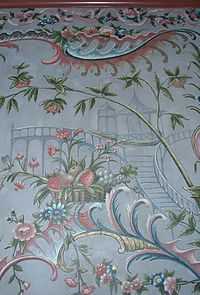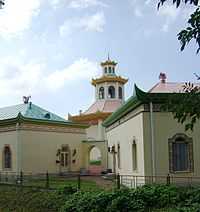Chinoiserie

Chinoiserie (pronounced [ʃinwazʁi], French for "Chinese-esque") is a recurring theme in European artistic styles since the seventeenth century, which reflect Chinese artistic influences.[2] It is characterized by the use of fanciful imagery of an imaginary China, by asymmetry in format and whimsical contrasts of scale, and by the attempts to imitate Chinese porcelain and the use of lacquerlike materials and decoration.
Chinoiserie in a broader scope refers to a mixture of Eastern and Western stylistic elements for both the decoration and shape.[3] The style held particular favour during the Rococo period and the court of Louis XV,[4] with which its fanciful, ornate and idyllic imagery is commonly associated.
History

_by_Fran%C3%A7ois_Boucher.jpg)
Chinoiserie entered the European repertory in the mid-to-late 17th century; the work of Athanasius Kircher had a lot of influence on the study of orientalism. The popularity of chinoiserie peaked around the middle of the 18th century, when it was easily assimilated into rococo by the works of François Boucher. It declined when it seemed to European eyes the very antithesis of neoclassicism.
Chinoiserie is often expressed in the decorative arts of Europe, and its expression in architecture was entirely in the field of whimsical follies. By contrast, the serious transformations that Chinese models effected in the eighteenth century, on the plain style of Early Georgian English furniture, notable in the cabriole leg, or on the "naturalistic" style of English landscape gardening, to take two clear examples, are not considered instances of "Chinoiserie".
Chinoiserie has made a comeback since the late 20th century. Modern interpretations of Chinoiserie incorporate modern design elements, and techniques. Chinoiserie can be seen as in influence in many housewares throughout Europe and North America.[citation needed]
Chinese porcelain

From the Renaissance to the 18th century Western designers attempted to imitate the technical sophistication of Chinese ceramics with only partial success. One of the earliest successful attempts, for instance, was the Medici porcelain manufactured in Florence during the late-16th century, as the Casino of San Marco remained open from 1575-1587.[5] Despite never being commercial in nature, the next major attempt to replicate Chinese porcelain was the soft-paste manufactory at Rouen in 1673, with Edme Poterat, widely reputed as creator of the French soft-paste pottery tradition, opening his own factory in 1647.[6] Efforts were eventually made to imitate hard-paste objects, which were held in high regard. As such, the direct imitation of Chinese designs in faience began in the late 17th century, was carried into European porcelain production, most naturally in tea wares, and peaked in the wave of rococo Chinoiserie (ca. 1740-1770).
Earliest hints of Chinoiserie appear in the early 17th century, in the arts of the nations with active East India Companies, Holland and England, then by mid-17th century, in Portugal as well. Tin-glazed pottery (see delftware) made at Delft and other Dutch towns adopted genuine blue-and-white Ming decoration from the early 17th century. After a book by Johan Nieuhof was published the 150 pictures encouraged chinoiserie, and became especially popular in the 18th century. Early ceramic wares at Meissen and other centers of true porcelain naturally imitated Chinese shapes for dishes, vases and tea wares.
Interior decoration



Various European monarchs, such as Louis XV of France, gave special favor to Chinoiserie, as it blended well with the rococo style. Entire rooms, such as those at Château de Chantilly, were painted with Chinoiserie compositions, and artists such as Antoine Watteau and others brought expert craftsmanship to the style.[7] Pleasure pavilions in "Chinese taste" appeared in the formal parterres of late Baroque and Rococo German and Russian palaces, and in tile panels at Aranjuez near Madrid. Chinese Villages were built in Drottningholm, Sweden and Tsarskoe Selo, Russia. Thomas Chippendale's mahogany tea tables and china cabinets, especially, were embellished with fretwork glazing and railings, ca 1753 - 70, but sober homages to early Qing scholars' furnishings were also naturalized, as the tang evolved into a mid-Georgian side table and squared slat-back armchairs suited English gentlemen as well as Chinese scholars. Not every adaptation of Chinese design principles falls within mainstream "chinoiserie". Chinoiserie media included "japanned" ware imitations of lacquer and painted tin (tôle) ware that imitated japanning, early painted wallpapers in sheets, after engravings by Jean-Baptiste Pillement, and ceramic figurines and table ornaments.
Architecture and gardens
Small pagodas appeared on chimneypieces and full-sized ones in gardens. Kew has a magnificent garden pagoda designed by Sir William Chambers, a replica of which was built in Munich's Englischer Garten. Though the rise of a more serious approach in Neoclassicism from the 1770s onward tended to replace Oriental inspired designs, at the height of Regency "Grecian" furnishings, the Prince Regent came down with a case of Brighton Pavilion, and Chamberlain's Worcester china manufactory imitated gaudy "Imari" wares. While classical styles reigned in the parade rooms, upscale houses, from Badminton House (where the "Chinese Bedroom" was furnished by William and John Linnell, ca 1754) and Nostell Priory to Casa Loma in Toronto, sometimes feature an entire guest room decorated in the chinoiserie style, complete with Chinese-styled bed, phoenix-themed wallpaper, and china. Later exoticisms added imaginary Turkish themes, where a "diwan" became a sofa.
Literary criticism
The term is also used in literary criticism to describe a mannered "Chinese-esque" style of writing, such as that employed by Ernest Bramah in his Kai Lung stories, Barry Hughart in his Master Li & Number Ten Ox novels and Stephen Marley in his Chia Black Dragon series.[8]
Fashion
The term is also used in the fashion industry to describe "designs in textiles, fashion, and the decorative arts that derive from Chinese styles".[9]
See also
Notes
- ↑ http://www.britannica.com/EBchecked/topic/372403/Medici-porcelain
- ↑ "Chinoiserie". The American Heritage Dictionary of the English Language. Retrieved 2008-07-28.
- ↑ Lambooy, S.M.R. (2010) Dutch Delftware. Facing East: Oriental Sources for Dutch Delfware Chinoiserie Figures, p. 8.
- ↑ http://www.encyclopedia.com/topic/chinoiserie.aspx#3-1E1:chinoise-full
- ↑ http://www.britannica.com/EBchecked/topic/372403/Medici-porcelain
- ↑ http://www.britannica.com/EBchecked/topic/510765/Rouen-ware
- ↑ Jan-Erik Nilsson. "chinoiserie". Gothenborg.com. Retrieved 2007-09-17.
- ↑ Marley rejects the chinoiserie label in favour of his own term, "Chinese Gothic".
- ↑ Calasibetta, Charlotte Mankey; Tortora, Phyllis (2010). The Fairchild Dictionary of Fashion. New York: Fairchild Books. ISBN 978-1-56367-973-5. Retrieved 2011-02-17.
Sources
- Eerdmans, Emily (2006). "The International Court Style: William & Mary and Queen Anne: 1689-1714, The Call of the Orient". Classic English Design and Antiques: Period Styles and Furniture; The Hyde Park Antiques Collection. New York: Rizzoli International Publications. pp. 22–25. ISBN 978-0-8478-2863-0.
- Honour, Hugh (1961). Chinoiserie: The Vision of Cathay. London: John Murray.
External links
| Wikimedia Commons has media related to Chinoiserie. |
| Look up chinoiserie in Wiktionary, the free dictionary. |
- Epoh Beech Uk Chinoiserie exponent
- Chinoiserie at Highbeam Encyclopedia
- (Getty Museum) "Imagining the Orient" exhibition, 2004-05.
- "Chinoiserie Style Guide". British Galleries. Victoria and Albert Museum. Retrieved 2007-07-17.
- Example of Chinoiserie in French Style Harpsichord
